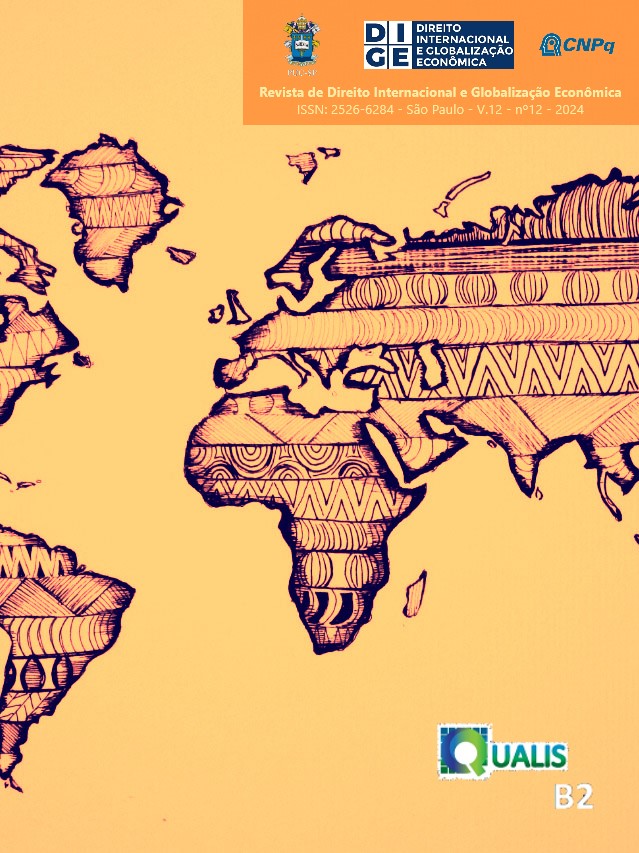Investimento Direto Chinês no MERCOSUL:
Como converge com os objetivos da Iniciativa Cinturão e Rota?
DOI:
https://doi.org/10.23925/2526-6284/2023.v12n12.65070Palabras clave:
MERCOSUL; Investimentos Estrangeiros Diretos; China; Iniciativa de Cinturão e Rota; InfraestruturaResumen
Como uma das maiores economias globais, a China mantém próximos laços políticos e econômicos com seus parceiros comerciais. O país objetiva reforçar essas conexões pela utilização de Investimento Estrangeiros Diretos (IED), se valendo da Iniciativa do Cinturão e Rota (ICR) em projetos de infraestrutura. Essa iniciativa almeja desenvolver a infraestrutura dos países dela participantes, solucionar a capacidade excedente em setores industriais chineses, promover a internacionalização do renminbi e reforçar os laços existentes. Nesse contexto, deve a situação do MERCOSUL ser considerada, vez que possuem uma duradoura relação com a China em termos comerciais e políticos. Portanto, o presente artigo verifica se o IED Chinês nos países do MERCOSUL converge com os objetivos da ICR mencionados. Através do método dedutivo conclui-se que nos três principais setores beneficiados pelo IED Chinês em cada país do MERCOSUL, independentemente de laços formais à ICR, existe um claro foco nos setores de Energia, Transporte e Metais, que não apenas convergem com os objetivos acima elencados, mas também garantem à China as commodities essenciais para alimentar a sua indústria de alta tecnologia.
Citas
AFONSO, D. L.; DE ANDRADE BASTOS, S. Q.; PEROBELLI, F. S. Latin America and China: mutual benefit or dependency? Cepal Review, v. 1, n. 135, p. 147–162, 2021. Available at <https://repositorio.cepal.org/server/api/core/bitstreams/f57b749c-78d5-4e7f-ab05-859fd20db144/content>. Accessed on 05/09/2023.
American Enterprise Institute. China Global Investment Tracker. Available at: <https://www.aei.org/china-global-investment-tracker/>. Accessed on: 25/8/2023.
BIALA, W. L.; LA KAR, C. C. Managing Chinese airlines: a case study of China Southern Airlines. Dissertation (Master’s Degree in Business Administration) - The Chinese of University of Hong Kong. Hong Kong, China, 2002. Available at: <https://openaccess.library.uitm.edu.my/Record/ndltd-cuhk.edu.hk-oai-cuhk-dr-cuhk_323695>. Accessed on 15/09/2023.
BOSWORTH, B. P.; COLLINS, S. M.; REINHART, C. M. Capital flows to developing economies: Implications for saving and investment. Brookings papers on economic activity, v. 1999, n. 1, p. 143, 1999. Available at: <http://dx.doi.org/10.2307/2534664>. Accessed on 25/08/2023.
CAI, W. Determinants of the renminbi anchor effect: From the perspective of the belt and road initiative. International journal of finance & economics, v. 27, n. 3, p. 3421–3433, 2022. Available at: <http://dx.doi.org/10.1002/ijfe.2328>. Accessed on 23/08/203.
Central European Bank. The internationalisation of currencies – A central banking perspective : Speech by Lorenzo Bini Smaghi, Member of the Executive Board of the ECB Conference “The euro at 10: The next global currency?” hosted by the Peterson Institute of International Economics and BRUEGEL Washington, 10 October 2008 Introduction. Available at: <https://www.ecb.europa.eu/press/key/date/2008/html/sp081010.en.html>. Accessed on 25/9/2023.
CHEN, W.; GONG, W.; JIANG, Z.; JIN, P. Regional economic competition, fiscal subsidies, and overcapacity. Journal of global information management, v. 30, n. 6, p. 1–19, 2022. Available at: <http://dx.doi.org/10.4018/jgim.313410>. Accessed on 24/08/2023.
CHRISTIAN, D. Silk roads or steppe roads? The silk roads in world history. Journal of world history: official journal of the World History Association, v. 11, n. 1, p. 1–26, 2000. Available at: <http://dx.doi.org/10.1353/jwh.2000.0004>. Accessed on 12/08/2023.
CROTTY, J. R. Why there is chronic excess capacity. Challenge; the magazine of economic affairs, v. 45, n. 6, p. 21–44, 2002. Available at: <http://dx.doi.org/10.1080/05775132.2002.11034176>. Accessed on 23/08/2023.
DONG, G.; WANG, L.; ZHANG, D. D.; et al. Climate-driven desertification triggered the end of the Ancient Silk Road, 2020. Available at: <http://dx.doi.org/10.5194/cp-2020-102>. Accessed on 20/07/2023.
European Bank for Reconstruction. Belt and Road Initiative (BRI). Available at: <https://www.ebrd.com/what-we-do/belt-and-road/overview.html>. Accessed on: 15/07/2023.
FUNG, K. C.; AMINIAN, N.; FU, X. (MAGGIE); KORNHOHEN, I. Internationalization of the use of Chinese currency: perspectives from the New and the Ancient Silk Roads. Journal of Chinese economic and business studies, v. 16, n. 1, p. 1–16, 2018. Available at: <http://dx.doi.org/10.1080/14765284.2017.1408255>. Accessed on 24/08/2023.
GHIASY, R.; ZHOU, J. THE SILK ROAD ECONOMIC BELT Considering security implications and EU-China cooperation prospects. Stockholm: Stockholm International Peace Research Institute, 2017. Available at <https://www.sipri.org/publications/2017/other-publications/silk-road-economic-belt>. Accessed on 16/08/2023.
HUANG, Y. Understanding China’s Belt & Road Initiative: Motivation, framework and assessment. China economic review, v. 40, p. 314–321, 2016. Available at: <http://dx.doi.org/10.1016/j.chieco.2016.07.007>. Accessed on 16/08/2023.
KOBOEVIĆ, Ž.; KURTELA, Ž.; VUJIČIĆ, S. The Maritime Silk Road and China’s Belt and Road Initiative. NAŠE MORE: znanstveni časopis za more i pomorstvo, p. 113–122, mar. 2018.
KOVAL, A. G.; ANDRIANOVA, E. K. MERCOSUR in trade policy clusters: challenges and prospects. Brazilian Journal of Political Economy, v. 42, n. 3, 2022. Available at: <http://dx.doi.org/10.1590/0101-31572022-3288>. Accessed on 12/08/2023.
LI, J.; VAN ASSCHE, A.; LI, L.; QIAN, G. Foreign direct investment along the Belt and Road: A political economy perspective. Journal of international business studies, v. 53, n. 5, p. 902–919, 2022. Available at: <http://dx.doi.org/10.1057/s41267-021-00435-0>. Accessed on 24/08/2023.
LIN, J.; KAHRL, F.; LIU, X. A regional analysis of excess capacity in China’s power systems. Resources, conservation, and recycling, v. 129, p. 93–101, 2018. Available at: <http://dx.doi.org/10.1016/j.resconrec.2017.10.009>. Accessed o 27/08/203.
LIU, T.; WANG, X.; WOO, W. T. The road to currency internationalization: Global perspectives and chinese experience. Emerging markets review, v. 38, p. 73–101, 2019. Available at: <http://dx.doi.org/10.1016/j.ememar.2018.11.003>. Accessed on 23/08/2023.
LIU, Z.; SCHINDLER, S.; LIU, W. Demystifying Chinese overseas investment in infrastructure: Port development, the Belt and Road Initiative and regional development. Journal of transport geography, v. 87, p. 102812, 2020. Available at: <http://dx.doi.org/10.1016/j.jtrangeo.2020.102812>. Accessed on 12/08/2023.
LONG, T.; URDINEZ, F. Status at the margins: Why Paraguay recognizes Taiwan and shuns China. Foreign policy analysis, v. 17, n. 1, p. 1–22, 2021. Available at: <http://dx.doi.org/10.1093/fpa/oraa002>. Accessed on 20/08/2023.
MERCOSUR. Décision sobre la suspension de Venezuela en el MERCOSUR. São Paulo: 2017. Available at <https://www.mercosur.int/suspension-de-venezuela-en-el-mercosur/>. Accessed on 28/08/2023.
NEDOPIL, C. Countries of the Belt and Road Initiative., Green Finance & Development Center, FISF Fudan University. Available at: <https://greenfdc.org/countries-of-the-belt-and-road-initiative-bri/>. Accessed on 12/08/2023.
NUGENT, J. B.; LU, J. China’s outward foreign direct investment in the Belt and Road Initiative: What are the motives for Chinese firms to invest? China economic review, v. 68, n. 101628, p. 101628, 2021. Available at: <http://dx.doi.org/10.1016/j.chieco.2021.101628>. Accessed on 20/08/2023.
OCDE. Foreign direct investment (FDI) - FDI flows - OECD Data. Available at: <https://data.oecd.org/fdi/fdi-flows.htm>. Accessed on: 20/07/2023.
PINI, A. M. A Crescente presença chinesa na América Latina : desafios ao Brasil. Boletim de Economia e Política Internacional, p. 21–31, 2015. Available at < https://repositorio.ipea.gov.br/handle/11058/6473>. Accessed on 19/08/2023.
ROSSABI, M. The “decline” of the central Asian caravan trade. In: J. D. Tracy (Org.); The Rise of Merchant Empires Long Distance Trade in the Early Modern World 1350–1750. p.351–370, 2011. Cambridge University Press. Available at < https://www.cambridge.org/core/books/abs/rise-of-merchant-empires/decline-of-the-central-asian-caravan-trade/8CCF8BA0EE6DC9D807DD334E4288BFF6>. Accessed on 23/07/2023.
SCHINDLER, S.; KANAI, J. M. Getting the territory right: infrastructure-led development and the re-emergence of spatial planning strategies. Regional studies, v. 55, n. 1, p. 40–51, 2021. Available at: <http://dx.doi.org/10.1080/00343404.2019.1661984>. Accessed on 23/08/2023.
SELBITSCHKA, A. The early Silk Road(s). Oxford Research Encyclopedia of Asian History, 28. mar. 2018. Oxford University Press. Available at < https://www.researchgate.net/publication/324794205_The_Early_Silk_Roads>. Accessed on 18/08/2023.
SEN, T. Inventing the ‘Maritime Silk Road’. Modern Asian studies, v. 57, n. 4, p. 1059–1104, 2023. Available at: <http://dx.doi.org/10.1017/s0026749x22000348>. Accessed on 29/08/2023.
SHEN, H. Building a Digital Silk Road? Situating the Internet in China’s Belt and Road Initiative. International Journal of Communication, v. 12, p. 2683–2701, 2018. Available at <https://ijoc.org/index.php/ijoc/article/view/8405>. Accessed on 22/08/2023.
SHIXUE, J. A New Look at the Chinese Relations With Latin America. NUEVA SOCIEDAD, n. 209, p. 70–86, 2006. Available at < https://www.researchgate.net/publication/228670677_A_New_Look_at_the_Chinese_Relations_With_Latin_America>. Accessed on 26/08/2023.
The Observatory of Economic Complexity. China. Available at: <https://oec.world/en/profile/country/chn>. Accessed on 26/08/2023.
The World Bank. Product exports and imports to China. 2021. Available at: <https://wits.worldbank.org/CountryProfile/en/Country/WLD/Year/2011/TradeFlow/EXPIMP/Partner/CHN/Product/all-groups>. Accessed on 23/08/2023.
TRADE AND DEVELOPMENT BOARD. Foreign direct investment, the transfer and diffusion of technology, and sustainable development: Note by the UNCTAD Secretariat. 2011. Available at <https://unctad.org/system/files/official-document/ciiem2d2_en.pdf>. Accessed on 24/08/2023.
URUGUAY. Law nº 16.906 of 20 january of 1998. Ley de Inverciones. Promocion Industrial. Montevideo: 1998. Available at < https://www.impo.com.uy/bases/leyes/16906-1998>. Accessed on 25/08/2023.
WANG, Q.; LIN, J.; ZHOU, K.; FAN, J.; KWAN, M.-P. Does urbanization lead to less residential energy consumption? A comparative study of 136 countries. Energy (Oxford, England), v. 202, n. 117765, p. 117765, 2020. Available at: <http://dx.doi.org/10.1016/j.energy.2020.117765>.
World Trade Organization. Trade Policy Review - Venezuela: Report by the Secretariat. 2022. Available at < https://docs.wto.org/dol2fe/Pages/SS/directdoc.aspx?filename=Q:/WT/TPR/S108-0.pdf&Open=True>. Accessed on 27/08/2023.
Xinhuanet. Full text of President Xi’s speech at opening of Belt and Road forum. Available at: <http://www.xinhuanet.com//english/2017-05/14/c_136282982.htm>. Accessed on: 05/08/2023.









